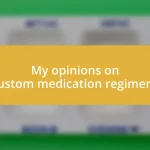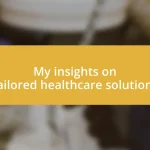Key takeaways:
- Challenges in gene therapy include delivery system limitations, regulatory hurdles, financial barriers, patient recruitment issues, and ethical considerations that require innovative solutions.
- Collaboration with medical experts and patient advocacy plays a critical role in navigating the complexities of gene therapy, fostering resilience and inspiring collective action for systemic change.
- The future of gene therapy holds promise with advancements in CRISPR technology, personalized medicine, and artificial intelligence, indicating a transformative potential for treating genetic disorders.

Introduction to Gene Therapy Challenges
Gene therapy has emerged as a beacon of hope for many genetic disorders, yet it comes with its own set of daunting challenges. I still remember the moment I first learned about it—a mixture of excitement and trepidation washed over me. Could this be the answer I had been searching for? But as I delved deeper, I realized that the road to successful gene therapy isn’t as straightforward as one might hope.
One major hurdle lies in the delivery systems used to introduce corrective genes into patients’ cells. When I first encountered the various methods, I felt overwhelmed. The complexity of choosing between viral vectors, nanoparticles, or physical methods brought a flurry of questions to my mind. How safe are these delivery systems? What are the potential side effects? Understanding these intricacies is crucial, but for a layperson, it can feel like navigating a maze with no clear exit.
Additionally, the regulatory landscape surrounding gene therapy raises concerns. I wondered: how can groundbreaking innovations in medicine overcome bureaucratic barriers? The tension between ensuring patient safety and fostering innovation often leads to frustrating delays. I’ve witnessed firsthand how these challenges can dampen hope, making it imperative for us to address and conquer them, paving the way for a brighter future in gene therapy.

Understanding the Common Obstacles
Understanding the obstacles in gene therapy feels like piecing together an intricate puzzle. As I navigated this journey, I often found myself grappling with the overwhelming array of challenges. From patient recruitment struggles to the unpredictability of immune responses, each hurdle brought its own emotional weight. It was during one particularly tough discussion with my healthcare team that I realized the importance of addressing these obstacles for everyone involved.
Here are some common obstacles I’ve encountered:
- Delivery System Limitations: Variability in patient responses to different methods and safety concerns can hinder effective therapy.
- Regulatory Hurdles: Navigating the complex and often slow-moving regulatory processes can delay access to potentially life-saving treatments.
- Financial Barriers: The high cost of gene therapy can restrict access for many patients, leaving them feeling helpless.
- Patient Recruitment Issues: Finding suitable candidates for trials can be challenging due to strict eligibility criteria, making it tough for researchers to gather data.
- Ethical Considerations: Questions about the long-term effects of gene editing raise ethical dilemmas that can add anxiety to already complicated choices.
Reflecting on these challenges sends a wave of empathy through me. I’ve witnessed the frustration of friends and fellow patients as they faced what seemed insurmountable. It’s a testament to the resilience of the human spirit, as we collectively strive for progress amid uncertainty.

Personal Experiences with Setbacks
It’s during moments of setback that I found my resolve truly tested. There was a time I faced a significant delay in my treatment due to unexpected regulatory concerns. I remember feeling a mix of frustration and sadness. It felt like I was on the verge of a breakthrough, only to be told to wait. That experience taught me the importance of patience and understanding in the complex world of gene therapy.
One of the most impactful setbacks I encountered was a severe reaction to an initial therapy attempt. The unexpected severity of my immune response left me feeling vulnerable and scared. As I sat in the hospital room, surrounded by the beeping machines, I faced a wave of self-doubt. Was I doing the right thing? I learned that setbacks don’t define our journey; rather, they can serve as powerful teachers, guiding us to reassess strategies and strengthen our resolve.
In another instance, I faced challenges with patient recruitment during a clinical trial. Watching my peers struggle to find participants brought feelings of helplessness. I questioned how many brilliant minds might be lost to bureaucracy. This experience ignited a fire within me to advocate for better systems, believing that sharing my story could inspire change. These setbacks, while painful, shaped not only my journey but also my perspective on the broader implications of gene therapy.
| Setback | Personal Experience |
|---|---|
| Regulatory Delays | Feeling frustrated and sad during treatment delays, realizing patience is essential. |
| Severe Immune Reaction | Faced vulnerability and self-doubt in the hospital, discovering setbacks can guide us. |
| Patient Recruitment Challenges | Witnessing peers struggle ignited a passion to advocate for better systems. |

Strategies for Overcoming Difficulties
When it came to delivery system limitations, I had to get creative. I remember brainstorming with my healthcare team about alternative methods. It felt empowering to explore different avenues rather than just accepting the limitations. Facing adversity often forces us to innovate. The discussions were filled with hope, and realizing that we had options made a significant difference in navigating the situation.
Dealing with regulatory hurdles was like trying to run a marathon with a heavy backpack. There were moments when I felt utterly defeated, waiting on approvals that seemed to take an eternity. But during those times, I learned to harness my impatience into advocacy, rallying support from others who shared my frustrations. I began to understand that while rules and regulations are necessary, pushing for transparency can help bridge the gap between science and the urgency of patient needs.
Financial barriers were another weight on my shoulders, especially when I saw other patients struggle with costs. I vividly recall sitting down with a friend facing a tough choice over whether to proceed with therapy due to financial concerns. Our conversations were filled with anxiety, yet they also sparked an idea. I realized that sharing stories could raise awareness and encourage fundraising efforts. It became clear that addressing financial challenges isn’t just about personal struggles; it’s about uniting voices to demand systemic changes that benefit all.

Collaborating with Medical Experts
Collaborating with medical experts has become a lifeline in my journey. I vividly recall the first time I sat down with a geneticist—her passion and knowledge were contagious. Together, we mapped out a strategy that felt personalized and hopeful. It was striking to see how her expertise turned what seemed like daunting challenges into manageable steps. Have you ever had that moment when a clear plan emerges from a chaotic situation? I found that conversations with medical professionals not only informed my choices but also provided support and reassurance.
In one pivotal meeting, a clinical trial coordinator shared their experience with similar cases. Hearing their stories made me realize I wasn’t alone in my struggles. Their insights prompted me to ask questions that I didn’t even know I had. I think that’s the beauty of engaging with experts—they help illuminate pathways that might not be visible at first. Isn’t it incredible how a simple conversation can open doors you never considered?
Finding the right collaborators was crucial as well. I learned that it wasn’t just about reaching out but building relationships. For instance, I remember my first interaction with a researcher who specialized in delivery methods for gene therapies. Their open-minded approach encouraged me to share my experiences, which then influenced their work. In retrospect, that connection was invaluable; it felt as though I became part of something greater, a community striving for innovation and understanding. Trust me, those relationships foster creativity and resilience that are essential in this complex field.

Learning from Patient Advocacy
Advocacy has been a powerful ally in my journey through gene therapy challenges. I still remember attending a patient advocacy conference where stories of resilience were painted vividly by those who shared their experiences. Listening to others’ journeys wasn’t just heartwarming; it added a layer of urgency to my own battles. Have you ever felt that rush of connection when you realize you’re not alone? It inspired me to leverage those shared experiences into something productive, igniting a passion for advocacy that I hadn’t tapped into before.
I found that listening to advocates speak about their personal trials empowered me to find my own voice. One moment stood out distinctly: a mother recounting her child’s struggle, and how her relentless efforts led to changes in policy. It struck a chord with me. The intersection of personal storytelling and activism was a revelation. I began to question how I could advocate for not just myself but for others facing similar struggles—seeking out forums and social media groups where we could amplify our voices together. This experience made it clear to me that advocacy is not always about grand gestures; sometimes, it’s about sharing our truth openly.
Moreover, I realized that patient advocacy can create powerful systemic changes. When a group of us shared our stories with public health officials, the impact was tangible. I could see the shift in their approach, understanding our needs rather than viewing us as mere statistics. I pondered, isn’t it fascinating how our narratives can reshape perspectives and policies? It became evident that connecting my narrative to a larger movement was a stepping stone toward focused efforts that may one day pave the way for breakthroughs. My journey taught me that advocacy isn’t just about overcoming personal obstacles; it’s about building bridges that transform challenges into collective action.

Future Directions in Gene Therapy
The future of gene therapy is brimming with potential, especially as we continue to learn from past challenges. I often find myself contemplating the next big leap. For instance, as scientists delve deeper into CRISPR technology, I see enormous promise in its ability to edit genes with precision. Imagine a world where genetic disorders are not just managed but eradicated entirely—how transformative would that be?
In addition to precision, collaboration across disciplines is becoming more vital. I remember attending a groundbreaking seminar where bioengineers and geneticists shared their insights on personalized medicine. Their discussions sparked excitement about tailored therapies designed specifically for individual genetic makeups. Isn’t it fascinating to think about how a treatment could be uniquely suited to my genetic profile? This collaboration may very well lead to breakthroughs that are more effective and safer for everyone.
Looking ahead, the integration of artificial intelligence promises to enhance gene therapy development significantly. I’ve had several conversations with researchers exploring AI’s potential to analyze vast datasets quickly. This technology could lead to identifying new targets for gene therapies that were once overlooked. It makes me wonder: what incredible discoveries are sitting just on the horizon, waiting for the right technology to reveal them? The combination of innovation, collaboration, and technology not only excites me but also feels like a gateway to a future where the challenges we face today could become stories of triumph tomorrow.














